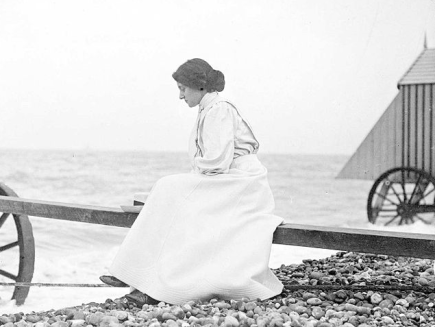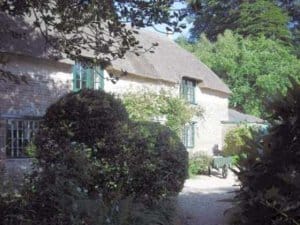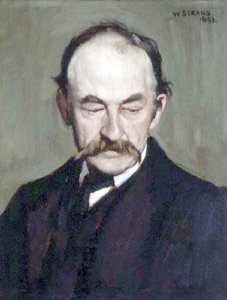The emotional distance Bowles set up between himself and his parents persisted throughout his life in his relations with other people. Reserve, dissociation and isolation are the underlying subjects of most of his work. His characters are frequently detached, unable to express their emotions or connect with other people. Like Bowles, they are passive, their actions determined by fate.
By the time he was nine years old Bowles had written a number of small piano pieces. He had his own column in the school magazine, the Oracle, and between 1926 and 1928 he published more than 40 pieces there, including several translations from French. He was very attracted to Modernism and Surrealism and practised automatic writing. He sent the results to Transition, which published several of his poems. He was just 17 years old and already sharing pages with James Joyce, Stein and André Breton.
In 1929, Aaron Copland became his music teacher. Copland was notorious for seducing his young male students. They became lovers and Bowles travelled with him to Berlin where Christopher Isherwood used his name for Sally Bowles in Goodbye to Berlin, which later becameCabaret. They visited Stein who said that he and Copland should go to Tangier, which they did.
Bowles married the writer Jane Auer in 1938 and they travelled in Central America and France. Friends were puzzled by the match because although Paul had taken both male and female lovers, Jane had been exclusively lesbian all her life. Paul and Jane were great friends, always joking and chattering together. However, they usually chose sexual partners with whom little communication was possible: Jane’s longest relationship was with Cherifa, a woman from the market in Tangier who spoke only Moghrebi, and Paul’s post-war lovers were illiterate Arab boys.
After travels in Central America, Bowles translated Sartre’s No Exit, the first of a long series of translations from French, Spanish and Moghrebi, which continued for the rest of his life. He became the music critic for the New York Herald Tribune and began publishing short stories.
Paul was diffident and removed in the extreme, often appearing callous towards his wife. Jane, a spoiled rich girl who never had to work, was forever causing scenes and having tantrums, and fretting over her work, which came very slowly. Her novel Two Serious Ladies, published in 1943, inspired Bowles to also write a novel.
The memory of Tangier haunted him. In 1947, with an advance for a novel, “I got on a Fifth Avenue bus one day to go uptown. By the time we had arrived at Madison Square I knew what would be in the novel and what I would call it… It would take place in the Sahara, where there was only the sky, and so it would be The Sheltering Sky.” By the time he reached midtown, he had made all the important decisions about this, his most celebrated book. Bernardo Bertolucci’s Bafta award-winning film ofThe Sheltering Sky was released in 1989, and featured Bowles himself as the narrator.
He left for Morocco, travelling with his boyfriend. Jane followed seven months later with her girlfriend. In Tangier they had separate apartments in the same building. Paul liked majoun, a form of hashish candy, and kif, and stayed up late, stoned, smoking with friends. Jane could not stand any form of cannabis, but was a heavy drinker; the probable cause of her stroke in 1957. When faced with the tricky prospect of describing the death of his protagonist, as a confirmed Surrealist, Bowles handed the problem over to his subconscious and took a large amount of majoun: “The majoun provided a solution totally unlike whatever I should have found without it.”
Bowles’s dedication to his third book, The Delicate Prey, read: “For my mother, who first read me the stories of Poe.” There is a sense of dread in his writing, that something terrible is about to happen, there is no safety anywhere, no security, each of us is essentially alone. Tennessee Williams, visiting Tangier at a time of political unrest, said: “It wasn’t the Arabs I was afraid of while I was in Tangier, it was Paul Bowles, whose chilling stories filled me with horror.”
Most of his characters were thinly veiled portraits. The Arab boy in The Spider’s House is based on Ahmed Yacoubi, Bowles's lover for a decade. Bowles: “As much as I was capable of loving anyone, I loved Yacoubi with an intense passion heretofore unknown to me. With Yacoubi, it was never ‘just sex’.” What constituted “just sex” for Bowles he never made clear, but he did speak of his love of being beaten. At school he goaded his fellow pupils into fighting with him. He always took punishment “stoically and ecstatically”. This became a feature of his adult relationships: “Being beaten,” he wrote to a friend, “[is] a vice. But how enjoyable. How exquisite. Biding myself with the pain, all the more enjoyable than misbehaving with some girl or man.”
Based largely on the publication of A Hundred Camels in the Courtyardand M’Hashish, Bowles found that his writing on the use of kif and majoun had made him a cult figure in the Sixties counter-culture. Hippies turned up at his door.
On May 4 1973, Jane Bowles died after years of ill health and rumours spread around Tangier that her lover Cherifa had poisoned her. Bowles himself was criticised for not getting better medical advice. He had been very passive, simply doing what the doctor advised without getting other medical opinions.
His fame grew. The Rolling Stones visited and he became an essential stop on the tour of north Africa. Film crews arrived from Sweden and France, Germany and Holland – as well as from the United States and Britain. Then in 1997 his health began to fail. He died following a heart attack on November 18 1999.
 |
Paul Bowles,1975
Photo by Dora Carringdon |
WORKS
MUSIC
1931 – Sonata for Oboe and Clarinet
1936 – Horse Eats Hat, play
1936 – Who Fights This Battle, play
1937 – Doctor Faustus, play
1937 – Yankee Clipper, ballet
1938 – Music for a Farce
1938 – Too Much Johnson, play
1938 – Huapango – Cafe Sin Nombre – Huapango-El Sol, Latin American folk
1939 – Denmark Vesey, opera
1939 – My Heart's in the Highlands, play
1940 – Loves Old Sweet Song, play
1940 – Twelfth Night, play
1941 – Liberty Jones, play
1941 – Watch on the Rhine, play
1941 – Love Like Wildfire, play
1941 – Pastorela, ballet
1942 – In Another Five Years Or So, opera
1943 – South Pacific, play
1943 – Sonata for Flute and Piano and Two Mexican Dances
1943 – 'Tis Pity She's a Whore, play
1944 – The Glass Managerie, play
1944 – Jacobowsky and the Colonel, play
1944 – Sentimental Colloquy, ballet
1945 – Ondine, play
1945 – Three, words by Tennessee Williams
1945 – Three Pastoral Songs
1946 – Night Without Sleep, words by Charles Henri Ford
1946 – Cyrano de Bergerac, play
1946 – The Dancer, play
1946 – Land's End, play
1946 – On Whitman Avenue, play
1946 – Twilight Bar, play
1946 – Blue Mountain Ballads [Heavenly Grass, Lonesome Man, Cabin, Sugar in the Cane ], words by Tennessee Williams, music by Paul Bowles.
1946 – Concerto for Two Pianos
1947 – Sonata for Two Pianos
1947 – Pastorela: First Suite, a ballet/opera in one act
1947 – The Glass Menagerie, words by Tennessee Williams, two songs by Bowles
1948 – Concerto for Two Pianos, Winds and Percussion
1948 – Summer and Smoke, play
1949 – Night Waltz
1953 – A Picnic Cantata
1953 – In the Summer House, play
1955 – Yerma, opera
1958 – Edwin Booth, play
1959 – Sweet Bird of Youth, play
1962 – The Milk Train Doesn't Stop Here Anymore, play
1966 – Oedipus (Sophocles), play
1967 – The Garden, play
1969 – The Bacchae(Euripides), play
1976 - Cross Country
1978 – Orestes, play
1978 – Caligula (Camus), play
1984 – Camp Cataract, play
1984 – A Quarreling Pair, play
1992 – Hippolytos, play
1992 – Black Star at the Point of Darkness
1993 – Salome, play








.jpg)










.jpg)